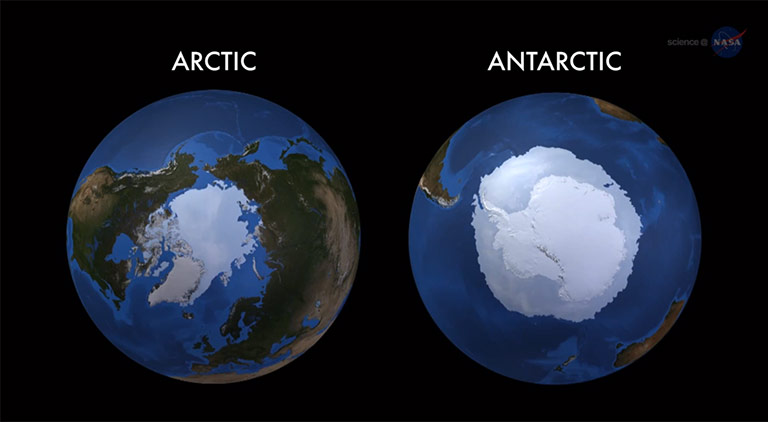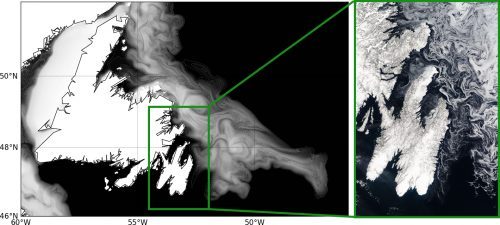Polar oceans and climate change
Polar oceans play a crucial role in the climate system by taking up and redistributing heat and carbon at global scale, thus greatly reducing the pace of climate warming.

Among all the regions of the ocean, the Southern Ocean and North Atlantic are the largest anthropogenic carbon sinks. In addition, the Southern Ocean is thought to be the largest sink for excess heat from the atmosphere in the global ocean. Over recent decades, polar oceans have experienced significant changes, including increases in air temperature, glacial melt, and winds, that are expected to further intensify over the 21st century. These changes have the potential to greatly impact the ability of polar oceans to continue taking up large amounts of heat and carbon dioxide from the atmosphere with important implications for climate warming. We are interested in identifying and quantifying the physical processes that drive the response of polar oceans to climate change.
Our current research activities focus on addressing the following questions:
- How are excess heat and anthropogenic carbon taken up in polar ocean regions, and will these sinks persist in the future?
- How is heat transported towards high-latitudes and how does that affect sea ice, ice-shelf melting and sea level?
- What drives the current sea ice variability and its response to climate change, and what impact will this response have on the regional and global climate?
To investigate these questions, we mainly use realistic models of the ocean-sea ice system or of the whole climate system. Though mainly focused on physical oceanography, our research has close connection with marine biogeochemistry (carbon cycle) and the cryosphere (sea ice and ice-shelves).
Current projects
Uptake, transport and subduction of heat and carbon in the Southern Ocean

The Southern Ocean plays a crucial role in the climate system by taking up large amounts of anthropogenic heat and carbon. Despite its pivotal role in climate, the Southern Ocean remains one of the most undersampled regions of the global ocean and where climate models generally perform most poorly. The objectives of this work are to investigate how heat and carbon are (1) transported meridionally across intense fronts and towards the Antarctic continent, (2) taken up by the Southern Ocean, and (3) subducted into the interior ocean. Of particular interest to this work is the role of mesoscale eddies. These transient or standing oceanic features of the order of 10 to 100 km are thought to play a significant role in the transport and subduction of heat and carbon, and in the uptake of carbon. By combining state of the art climate model simulations and the most recent observations of the Southern Ocean, we propose to examine the current and future role of the Southern Ocean in the climate system.
Interaction between sea ice and ocean at fine scale

Fundamental questions remain on how polar regions will respond to climate change and how rapidly changes will occur. One of the burning questions relates to the role played by the ocean in shaping the sea ice cover and on the subsequent impact on sea ice melting. As satellite sensors become more able to capture small scale features, there is growing evidence that ocean and sea ice interact at fine scale, suggesting for instance that ocean mesoscale and submesoscale eddies significantly influence sea ice spatial and temporal patterns. Furthermore, most climate models overestimate sea ice extent, suggesting that key processes responsible for transporting heat toward the sea ice region are missing in these models. Addressing the role of oceanic fine scale processes on sea ice pattern and evolution is key to improve our ability to project climate change. This is of particular relevance to the Arctic where dramatic melting of the sea ice cover has been observed over the past decades. We propose to investigate the interaction between ocean and sea ice at fine scale by performing numerical simulations at very high-resolution (< 1 km).
Role of bathymetry and mesoscale eddies in ocean heat transport toward the Arctic basin
Arctic sea ice has declined dramatically over the past decades. Some climate model scenarios suggest that the summer Arctic Ocean could be free of ice by 2050. This accelerated sea ice decline has a huge
impact on regional and global climate, coastal communities and infrastructures, shipping and maritime
safety.

Ocean heat transport is thought to be one of the main mechanisms responsible for that decline. Yet, the intensity, pattern and variability of ocean heat transport to the Arctic basin are not well known, nor are the key processes that need to be well-represented in climate models to reduce uncertainties in climate projections. The goal of this research proposal is to advance our understanding of the role of ocean heat transport on the response of Arctic sea ice to climate change. More specifically, we propose to examine the role of bathymetry and ocean mesoscale eddies on Atlantic warm water inflow, and how this role shapes the intensity and pattern of sea ice decline. This project will address fundamental and pressing questions on processes involved in heat transport to the Arctic sea ice, while informing the scientific community on the improvements needed to reduce uncertainties in climate projections.